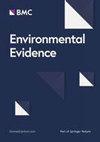线性交通基础设施边坡能否成为温带生态系统中维管植物的栖息地和/或走廊?系统回顾
IF 5.2
4区 环境科学与生态学
Q2 ENVIRONMENTAL SCIENCES
引用次数: 0
摘要
线性交通基础设施(公路、铁路、石油和天然气管道、电力线和水道)被认为是造成物种栖息地破碎化的重要因素。另一方面,线性交通基础设施(公路和铁路路堤、电力线下或埋设管道上方的草带或水道堤岸)的边缘则形成了巨大的连续栖息地网络。虽然自然栖息地的丧失仍然对生物多样性构成重大威胁,但路边草地可以为人为地区提供栖息地或走廊,尽管这种保护潜力仍然存在争议。本文是首次针对温带生态系统中的维管植物(严格意义上的水生物种除外)进行的证据综述。我们提出了以下问题:线性交通基础设施边坡能否构成温带生态系统中维管束植物的栖息地和/或走廊?我们利用两个在线书目数据库、三个搜索引擎和专业网站进行了系统的文献调查,并向相关专家发出了文献征集令。我们还整合了之前系统综述中范围重叠的研究。我们根据先验协议中详细列出的标准,先后对文章的标题、摘要和全文进行了相关性筛选。然后,我们使用六个具体问题对所选研究进行分类和批判性评估。这些问题包括路边作为维管植物栖息地和走廊的潜力,以及景观和管理对这些潜力的影响。我们为存在低度和中度偏差风险的研究建立了一个数据库。我们在叙述性综述中对特定问题的研究结果进行了归纳。最后,我们对符合荟萃分析标准的有关林缘植物生境作用的研究进行了定量综合。我们的系统文献调查产生了 101524 条搜索结果。经过严格评估后,我们将 294 篇文章纳入了系统综述,这些文章共报告了 316 项研究。大多数研究都是沿着道路边缘或河岸进行的,只有少数研究涉及电线、铁路或管道。由于相关研究太少,我们无法就路边作为维管植物走廊的作用得出结论。不过,关于路边绿化带的栖息地功能,我们根据 47 项主要研究中的 205 个案例进行了荟萃分析,比较了路边绿化带与远离交通基础设施的栖息地中外来物种、本地物种或所有物种的丰度和/或物种丰富度。就非公路路边而言,外来物种在非公路路边的丰度和丰富度都更高,但我们没有发现一般物种或本地物种之间的显著差异,这意味着外来物种通常会增加而不是减少物种。证据库中还包含多种管理方法。总体而言,对物种丰富度或丰度的系统性影响很少出现,但人类干预很少是中性的,通常至少会暂时改变本地植物群与外来植物群之间或各种功能群之间的平衡。我们发现,在线性交通基础设施边坡作为维管植物走廊的潜力方面,还存在很大的知识空白。因此,我们呼吁就这一特定主题开展更多研究,特别是鉴于证据综述强调了路边作为外来和入侵植物区系栖息地的潜力。本文章由计算机程序翻译,如有差异,请以英文原文为准。
Can linear transportation infrastructure verges constitute a habitat and/or a corridor for vascular plants in temperate ecosystems? A systematic review
Linear transportation infrastructures (roads, railways, oil and gas pipelines, powerlines and waterways) are recognized as important contributors to the fragmentation of species habitats. On the other hand, verges of linear transportation infrastructures (road and railway embankments, strips of grass under power lines or above buried pipelines, or waterway banks) form vast networks of continuous habitats. While the loss of natural habitats still poses a significant threat to biodiversity, verges can provide habitats or corridors in anthropogenic areas, although this potential for conservation remains controversial. The current paper is the first synthesis of evidence addressing this topic for vascular plants (except strictly aquatic species) in temperate ecosystems. We asked the following question: can linear transportation infrastructure verges constitute habitats and/or corridors for vascular plants in temperate ecosystems? We conducted a systematic literature survey using two online bibliographic databases, three search engines, specialist websites, and by sending a call for literature to subject experts. We also integrated studies from a previous systematic review with an overlapping scope. We successively screened the articles for relevance on titles, abstracts and full texts using criteria detailed in an a priori protocol. We then used six specific questions to categorize the selected studies and critically assess them. These questions encompassed the potential of verges as habitats and corridors for vascular plants, and the effects of landscape and management on these potentialities. We created a database of the studies with low and medium risk of bias. We synthesized results for specific questions in narrative syntheses. Finally, studies about the habitat role of verges that met the criteria for a meta-analysis were used for quantitative syntheses. Our systematic literature survey yielded 101,524 search results. After critical appraisal, we included in our systematic review 294 articles that reported 316 studies. Most studies were conducted along road verges or waterway banks, with only a handful of studies involving powerlines, railways or pipelines. We were not able to draw conclusions on the role of verges as corridors for vascular plants as too few relevant studies were obtained. Regarding the habitat function of verges however, meta-analyses were conducted based on 205 cases from 47 primary studies that compared abundance and/or species richness in verges vs habitats away from transportation infrastructure for exotic, native or all species together. For non-highway road verges, both the abundance and richness of exotic species were higher on non-highway road verges, but we found no significant differences among species in general, or for native species specifically, which implies that alien species would often add but not subtract species. A wide variety of management practices were also represented in the evidence base. Overall, systematic impacts on species richness or abundance rarely emerged, but human interventions were seldom neutral and usually altered, at least temporarily, the balance between the native and exotic flora or among various functional groups. We identified a major knowledge gap regarding the potential of linear transportation infrastructure verges as corridors for vascular plants. Thus, we call for more research on this particular topic, especially as the evidence synthesis underlined the potential of verges as habitat for exotic and invasive flora.
求助全文
通过发布文献求助,成功后即可免费获取论文全文。
去求助
来源期刊

Environmental Evidence
Environmental Science-Management, Monitoring, Policy and Law
CiteScore
6.10
自引率
18.20%
发文量
36
审稿时长
17 weeks
期刊介绍:
Environmental Evidence is the journal of the Collaboration for Environmental Evidence (CEE). The Journal facilitates rapid publication of evidence syntheses, in the form of Systematic Reviews and Maps conducted to CEE Guidelines and Standards. We focus on the effectiveness of environmental management interventions and the impact of human activities on the environment. Our scope covers all forms of environmental management and human impacts and therefore spans the natural and social sciences. Subjects include water security, agriculture, food security, forestry, fisheries, natural resource management, biodiversity conservation, climate change, ecosystem services, pollution, invasive species, environment and human wellbeing, sustainable energy use, soil management, environmental legislation, environmental education.
 求助内容:
求助内容: 应助结果提醒方式:
应助结果提醒方式:


